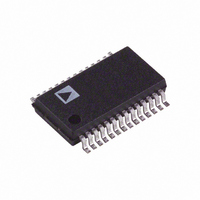AD9224ARS Analog Devices Inc, AD9224ARS Datasheet - Page 15

AD9224ARS
Manufacturer Part Number
AD9224ARS
Description
IC ADC 12BIT 40MSPS 28-SSOP
Manufacturer
Analog Devices Inc
Datasheet
1.AD9224ARSZRL.pdf
(24 pages)
Specifications of AD9224ARS
Rohs Status
RoHS non-compliant
Number Of Bits
12
Sampling Rate (per Second)
40M
Data Interface
Parallel
Number Of Converters
7
Power Dissipation (max)
450mW
Voltage Supply Source
Single Supply
Operating Temperature
-40°C ~ 85°C
Mounting Type
Surface Mount
Package / Case
28-SSOP (0.200", 5.30mm Width)
For Use With
AD9224-EB - BOARD EVAL FOR AD9224
Available stocks
Company
Part Number
Manufacturer
Quantity
Price
Part Number:
AD9224ARS
Manufacturer:
ADI/亚德诺
Quantity:
20 000
Company:
Part Number:
AD9224ARSZ
Manufacturer:
AD
Quantity:
1 600
Part Number:
AD9224ARSZ
Manufacturer:
ADI/亚德诺
Quantity:
20 000
Part Number:
AD9224ARSZRL
Manufacturer:
ADI/亚德诺
Quantity:
20 000
REV. A
The driver circuit shown in Figure 23 is optimized for dc cou-
pling applications requiring optimum distortion performance.
This differential op amp driver circuit is configured to convert
and level shift a 2 V p-p single-ended, ground referenced signal
to a 4 V p-p differential signal centered at the VREF level of the
ADC. The circuit is based on two op amps that are configured
as matched unity gain difference amplifiers. The single-ended
input signal is applied to opposing inputs of the difference am-
plifiers, thus providing differential drive. The common-mode
offset voltage is applied to the noninverting resistor leg of each
difference amplifier providing the required offset voltage. The
common-mode offset can be varied over a wide span without
any serious degradation in distortion performance as shown in
Figure 25a, thus providing some flexibility in improving output
compression distortion from some 5 V op amps with limited
positive voltage swing.
To protect the AD9224 from an undervoltage fault condition
from op amps specified for 5 V operation, two diodes to AGND
can be inserted between each op amp output and the AD9224
inputs. The AD9224 will inherently be protected against any
overvoltage condition if the op amps share the same positive
power supply (i.e., AVDD) as the AD9224. Note, the gain
accuracy and common-mode rejection of each difference ampli-
fier in this driver circuit can be enhanced by using a matched thin-
film resistor network (i.e., Ohmtek ORNA5000F) for the op
amps. The AD9224’s small signal bandwidth is 120 MHz, hence
any noise falling within the baseband bandwidth of the AD9224
will degrade its overall noise performance.
The noise performance of each unity gain differential driver
circuit is limited by its inherent noise gain of two. For unity gain
op amps ONLY, the noise gain can be reduced from two to one
beyond the input signal’s passband by adding a shunt capacitor,
C
establish a low-pass filter, which reduces the noise gain to one
beyond the filter’s f
input signal to f
can also be used as the real pole of an antialiasing filter.
Figure 24 shows the schematic of the suggested transformer
circuit. The circuit uses a Minicircuits RF transformer, model
T4-1T, which has an impedance ratio of four (turns ratio of 2).
The schematic assumes that the signal source has a 50
impedance. The 1:4 impedance ratio requires the 200
ondary termination for optimum power transfer and VSWR.
The center tap of the transformer provides a convenient
means of level shifting the input signal to a desired common-
mode voltage.
This (Figure 24) configuration was used to gather all of the
differential data on the Specifications pages.
F
, across each op amp’s feedback resistor. This will essentially
49.9
Figure 24. Transformer Coupled Input
MINICIRCUITS
–3 dB
T4-1T
. Note, the pole established by this filter
–3 dB
while simultaneously bandlimiting the
200
33
33
R
R
S
S
0.1 F
VINA
VINB
CML
AD9224
sec-
source
–15–
Transformers with other turns ratios may also be selected to
optimize the performance of a given application. For example, a
given input signal source or amplifier may realize an improve-
ment in distortion performance at reduced output power levels
and signal swings. For example, selecting a transformer with a
higher impedance ratio (e.g., Minicircuits T16-6T with a 1:16
impedance ratio) effectively “steps up” the signal level thus
further reducing the driving requirements of signal source.
Referring to Figure 24, a series resistor, R
the AD9224 and the secondary of the transformer. The value of
33
SNR performance of the A/D. R
help provide a low-pass filter to block high frequency noise.
The AD9224 can be easily configured for either a 2 V p-p input
span or 4.0 V p-p input span by setting the internal reference
(see Table II). Other input spans can be realized with two exter-
nal gain setting resistors as shown in Figure 28 of this data
sheet. Figure 25a demonstrates the AD9224’s high degree of
linearity and THD over a wide range of common-mode
voltages.
Figure 25a. THD vs. Common-Mode Voltage (AIN = 2 V
Differential)
Figure 25b. Frequency Domain Plot F
40 MHz (A
was selected to specifically optimize both the THD and
–100
–110
–120
84
82
80
78
76
74
72
–10
–20
–30
–40
–50
–60
–70
–80
–90
10
0.5
0
0
f
f
IN
IN
IN
FUND
= 10MHz
= 20MHz
= 2 V Differential)
2ND
8
1
17.25 26.5
3RD
COMMON-MODE VOLTAGE – V
COMMON-MODE VOLTAGE – V
5TH
2
6TH
35.7 45E6 54.25
7TH
S
2.5
8TH
and the internal capacitance
9TH
S
, was inserted between
3
IN
63.5 72.75
= 5 MHz, F
AD9224
4
82
4.5
S
=













